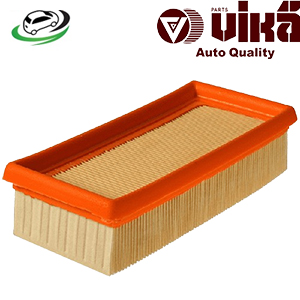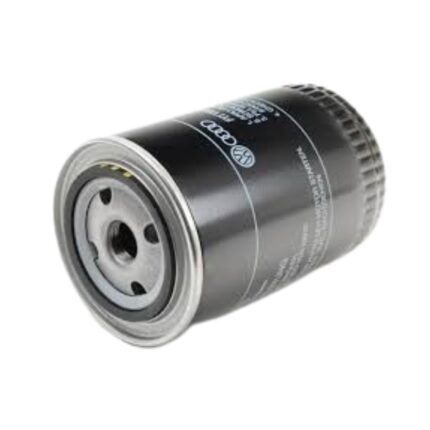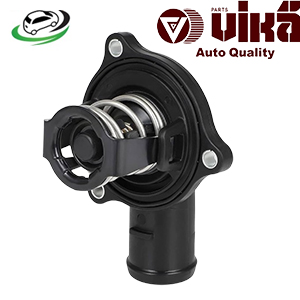Get AUDI A4 B7 (8EC)/ A6 C6 (4F2/ Q7 (4LB)/ Q7 Van (4LB) / VW Phaenton/ Touareg (7LA 7L6 7L7) Water Coolant Thermostat Housing 059121111F
The water coolant thermostat housing is a component of the engine’s cooling system that houses the thermostat. It serves as the connection point between the engine block and the radiator, regulating the flow of coolant through the system. In simple terms, it acts as the gateway for coolant to either remain within the engine or flow to the radiator for cooling, depending on the engine’s temperature.
The thermostat inside the housing is responsible for opening and closing the coolant passage based on the engine’s temperature. The thermostat housing itself is usually made from metal or durable plastic, depending on the vehicle’s design.
2. Function of the Water Coolant Thermostat Housing
The thermostat housing has several key functions that are essential for the proper operation of an engine’s cooling system.
1. Houses the Thermostat
- The primary function of the thermostat housing is to protect and secure the thermostat, which is a small device that monitors the engine’s temperature and controls the flow of coolant. The thermostat remains closed when the engine is cold, allowing the engine to warm up quickly. Once the engine reaches its optimal operating temperature, the thermostat opens, allowing coolant to flow to the radiator and prevent overheating.
2. Regulates Coolant Flow
- The thermostat housing, in conjunction with the thermostat, controls the flow of coolant between the engine and the radiator. When the engine is cold, the thermostat stays closed to block coolant from flowing to the radiator, allowing the engine to heat up quickly. As the engine warms up, the thermostat opens, allowing the coolant to circulate through the radiator, which cools the liquid and helps maintain the ideal engine temperature.
3. Prevents Overheating and Undercooling
- By regulating the flow of coolant, the thermostat housing ensures that the engine stays within a specific temperature range. If the engine overheats or remains too cool for too long, it can result in poor performance, increased fuel consumption, and potential engine damage.
3. Types of Water Coolant Thermostat Housing
Thermostat housings come in different types, depending on the material used and the vehicle design. The most common types are:
1. Aluminum Thermostat Housing
- Description: Many vehicles use aluminum thermostat housings due to their durability, heat resistance, and corrosion resistance. Aluminum is lightweight, making it an ideal choice for performance-oriented vehicles.
- Pros: Lightweight, durable, and corrosion-resistant.
- Cons: More expensive to produce and replace than plastic housings.
2. Plastic Thermostat Housing
- Description: Some vehicles use plastic thermostat housings due to their cost-effectiveness and ease of manufacturing. Plastic housings are less durable than aluminum and more susceptible to cracking or warping due to heat.
- Pros: Inexpensive and lightweight.
- Cons: Less durable, prone to cracking, and can warp over time due to heat exposure.
3. Integrated Thermostat Housing
- Description: In some modern vehicles, the thermostat housing is integrated with the thermostat, meaning the thermostat cannot be removed or replaced without replacing the entire housing. This type of design simplifies the manufacturing process but increases replacement costs.
- Pros: Simplified design, reduced complexity.
- Cons: More expensive to replace, as the entire unit must be changed if the thermostat fails.
4. Remote Thermostat Housing
- Description: Some vehicles use a remote thermostat housing, where the thermostat is located away from the engine block, typically near the radiator or other cooling components. This design is used in specific cooling system configurations.
- Pros: Allows for more flexible cooling system designs.
- Cons: Less common, may be more complicated to service.
4. Symptoms of a Failing Thermostat Housing
A faulty thermostat housing can lead to several engine performance problems, most of which are related to improper temperature regulation. Common symptoms of a failing or damaged thermostat housing include:
1. Coolant Leaks
- One of the most common signs of a failing thermostat housing is coolant leaks. A crack or damage in the housing can cause coolant to leak, leading to a drop in coolant levels and potential engine overheating. You may notice puddles of coolant under the vehicle or around the engine.
2. Engine Overheating
- A malfunctioning thermostat or damaged housing can prevent the proper flow of coolant, causing the engine to overheat. Overheating can lead to severe engine damage, including warped cylinder heads or a blown head gasket.
3. Temperature Fluctuations
- If the thermostat housing is damaged or if the thermostat inside it is malfunctioning, you may notice fluctuating engine temperatures. The engine may run too hot or too cold, affecting performance and fuel efficiency.
4. Check Engine Light
- Modern vehicles have sensors that monitor engine temperature. If the thermostat housing fails and causes temperature issues, the check engine light may turn on. A diagnostic scan may reveal a code related to the cooling system.
5. Coolant Smell
- A cracked or damaged thermostat housing may cause coolant to leak, leading to a strong coolant odor in the engine bay. Coolant has a sweet smell that is easy to identify, and you may notice the smell both inside and outside the vehicle.
5. Causes of Thermostat Housing Failure
Several factors can contribute to the failure of the thermostat housing, including:
1. Age and Wear
- Over time, the thermostat housing, like any component, can wear out. The materials used in the housing, whether aluminum or plastic, can degrade with age due to constant exposure to heat and engine vibrations.
2. Overheating
- Excessive engine heat can cause the thermostat housing to warp or crack, especially in plastic housings. Overheating may be the result of a malfunctioning thermostat, a clogged radiator, or low coolant levels.
3. Corrosion
- In aluminum thermostat housings, corrosion can occur due to electrochemical reactions between the metal and the coolant. Corrosion weakens the housing, leading to cracks or leaks over time.
4. Improper Coolant
- Using the wrong type of coolant or neglecting regular coolant changes can lead to the buildup of deposits or corrosion inside the cooling system, including the thermostat housing. These deposits can damage the housing and affect its ability to seal properly.
6. Maintenance and Replacement Tips
Proper maintenance of the thermostat housing is essential to ensure the longevity of the cooling system and to prevent engine damage. Here are some maintenance tips:
1. Regular Coolant Flushes
- Regularly flushing and replacing the coolant ensures that the cooling system remains free from contaminants, deposits, and corrosion. This helps prolong the life of the thermostat housing and other cooling system components.
2. Inspect for Leaks
- Periodically inspect the thermostat housing and surrounding components for signs of coolant leaks. Look for cracks, corrosion, or warping in the housing, and check for coolant puddles around the engine.
3. Replace the Thermostat with the Housing
- When replacing the thermostat, it’s often a good idea to replace the housing as well, especially if the housing is plastic. The cost of a new housing is relatively low, and it can prevent future problems.
4. Use the Correct Coolant
- Always use the manufacturer-recommended coolant for your vehicle. Using the wrong type of coolant can lead to corrosion, deposit buildup, and thermostat housing failure.
5. Replace When Necessary
- If you notice any of the symptoms of a failing thermostat housing, it’s essential to replace it promptly. Delaying repairs can lead to more serious engine damage and higher repair costs.
7. Thermostat Housing Replacement Procedure
Replacing the thermostat housing is a straightforward process, but it can vary depending on the vehicle make and model. Below is a general guide to replacing the thermostat housing:
1. Drain the Coolant
- Start by draining the coolant from the radiator to prevent any spills when removing the thermostat housing.
2. Remove the Housing
- Locate the thermostat housing, usually near the top of the engine block, and remove any bolts securing it. Be sure to disconnect any hoses attached to the housing.
3. Remove the Thermostat
- Once the housing is removed, take out the thermostat. Inspect the old thermostat for signs of damage or wear.
4. Clean the Area
- Clean the mating surfaces where the thermostat housing connects to the engine. Any debris or old gasket material can prevent a proper seal.
5. Install the New Thermostat and Housing
- Place the new thermostat in the housing and secure it with the bolts. Reattach any hoses and ensure everything is properly connected.
6. Refill the Coolant
- Refill the cooling system with fresh coolant and bleed any air from the system to prevent air pockets.
7. Test the System
- Start the engine and allow it to warm up. Check for any leaks and ensure the engine temperature is stable.
Conclusion
The water coolant thermostat housing is a vital component of the engine’s cooling system, responsible for regulating the flow of coolant and ensuring the engine operates at its optimal temperature. Proper maintenance and timely replacement of the thermostat housing can prevent serious engine issues like overheating, coolant leaks, and fluctuating temperatures. Whether made from plastic or aluminum, understanding the signs of a failing thermostat housing and taking preventive steps can extend the life of your engine and improve vehicle performance.
Follow us on Facebook for more parts.




Reviews
Clear filtersThere are no reviews yet.